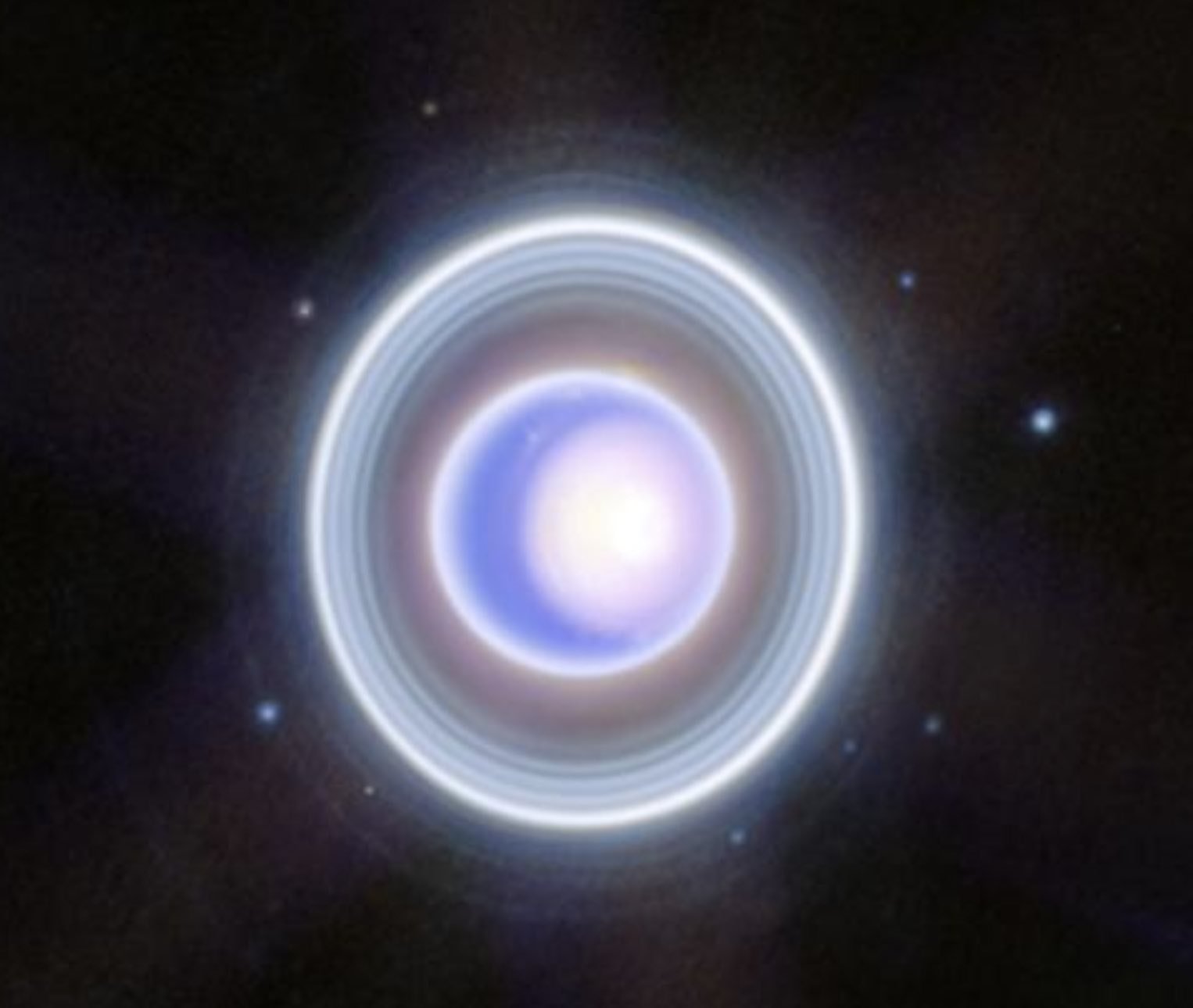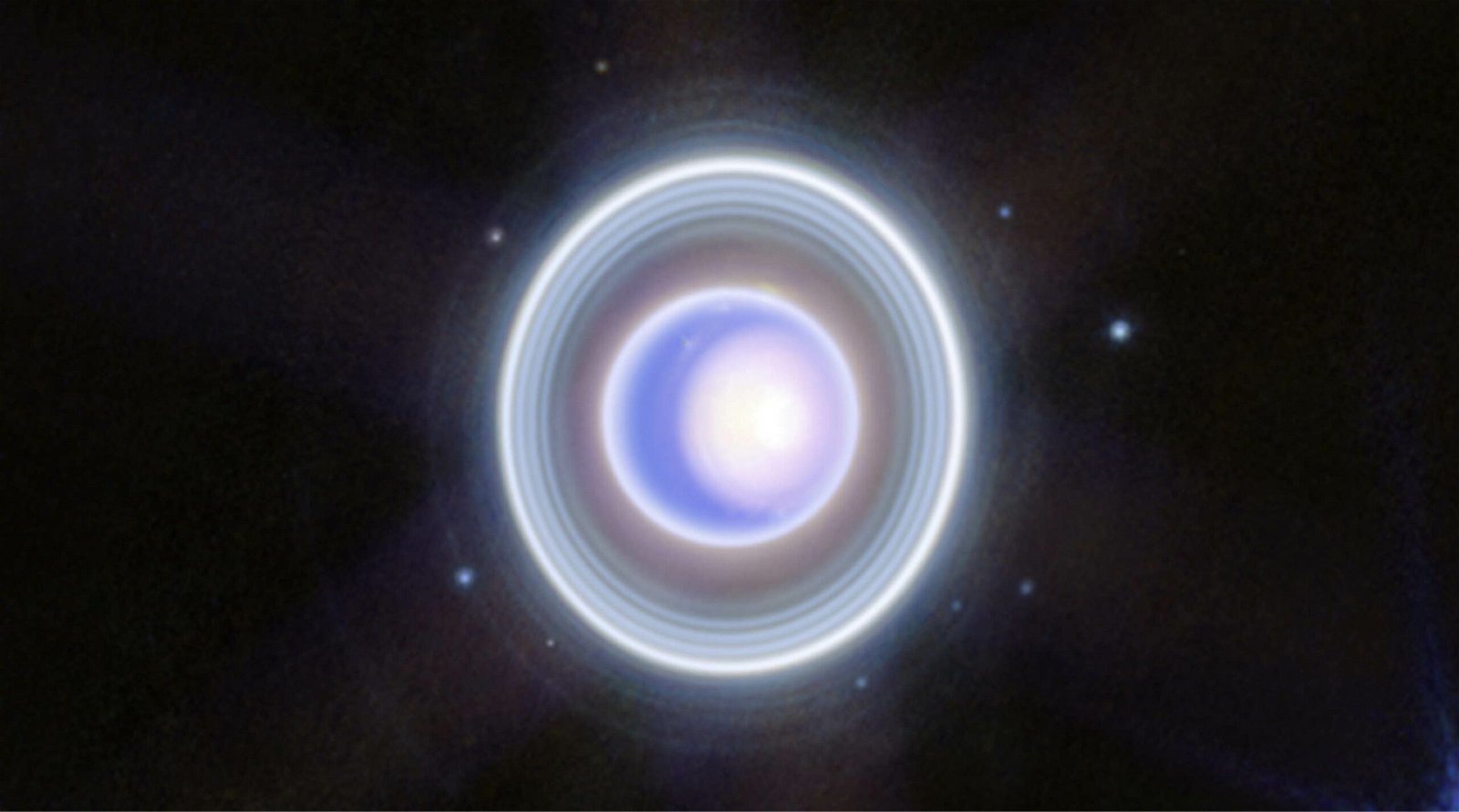NASA has released stunning new imagery of the ice giant Uranus captured by its premiere space observatory, the James Webb Space Telescope.
The seventh planet from the Sun in our solar system, the orbit of icy Uranus falls between that of the gas giants Jupiter and Neptune, where, unlike other planets in our solar system, it spins on its side.
Blue is the Hue
Uranus possesses a striking bluish-green color, caused by its atmosphere composed primarily of helium and hydrogen, which the new imagery captured by the James Webb Space Telescope showcases in remarkable clarity, along with several of the planet’s twenty-seven known satellites.
Referring to the Webb imagery, NASA recently called the planet “unusual and enigmatic,” describing it as a “dynamic world with rings, moons, storms,” and a range of other features.


The new image is based on enhancements of a two-color version of the same view of Uranus released earlier in 2023, which employs additional wavelength coverage that allows more details to be revealed in the latest versions.
Rings and Things
While Saturn is the planet most renowned for its rings, Uranus is no slouch when it comes to the striking series of bands encircling it. Thanks to Webb and its unrivaled sensitivity, even the faintest outermost rings of Uranus, as well as its most elusive ring of all—the Zeta ring—which is positioned the closest to the planet of all its rings, can be seen in the new imagery.
Surrounding the enigmatic-looking planet are several of its moons, including Titania and Oberon, some of which can even be seen amidst the planet’s rings.
The new imagery is markedly different from previous photos of Uranus captured by the Voyager 2 probe decades ago, primarily because the more “unusual and enigmatic” features of the planet (to again borrow NASA’s characterization) only become visible at infrared wavelengths, which were not able to be obtained by Voyager’s cameras in the 1980s.
“In infrared wavelengths, Webb is revealing a strange and dynamic ice world filled with exciting atmospheric features,” read a NASA statement that appeared on the agency’s official page devoted to the James Webb Space Telescope.
An Icy Planet with a Cloud Cap
Also revealed in unprecedented detail in the new imagery is the cloudy cap that adorns the planet’s north pole at certain times of the Uranian year. With the details that emerged in the newly enhanced versions of the images, both the seasonal cap, as well as a darker region near the bottom of the polar cap, can all be seen.
Beneath the planet’s north pole cap, several weather formations can be discerned in the imagery, revealing storm activity. Currently, planetary scientists are unclear about how many of these storms may be present, and how often they occur.
As Uranus tilts toward the Sun, its polar cap appears to become more prominent with the approach of the planet’s solstice, the next of which will occur in 2028. During these seasonal periods, scientists believe the extra sunlight the planet receives probably influences its unique atmosphere and the weather occurring within it.
James Webb Space Telescope Reveals Clues to Uranus’s Tilt
Weather on Uranus is also impacted by the planet’s unique orientation, which causes it to possess the greatest seasonal extremities of any planet in the solar system. A significant portion of each year sees one of the planet’s poles cast in near-constant sunlight. By contrast, the “dark side” of the planet facing away from the Sun endures winters lasting nearly 21 years.
Scientists are uncertain why Uranus spins on its side at an exaggerated tilt of close to 98 degrees, although theories include the possibility that the planet may have impacted with another large object at some point in the past, knocking it into its current “tilted” position.
The newly enhanced Webb telescope imagery provides astronomers with the most detailed view of the planet ever obtained, revealing its most visually striking elements with incredible clarity, and allowing scientists to plan for future missions that will focus on revealing more of the mysteries about the most unique planet in our solar system.
Micah Hanks is the Editor-in-Chief and Co-Founder of The Debrief. He can be reached by email at micah@thedebrief.org. Follow his work at micahhanks.com and on X: @MicahHanks.

